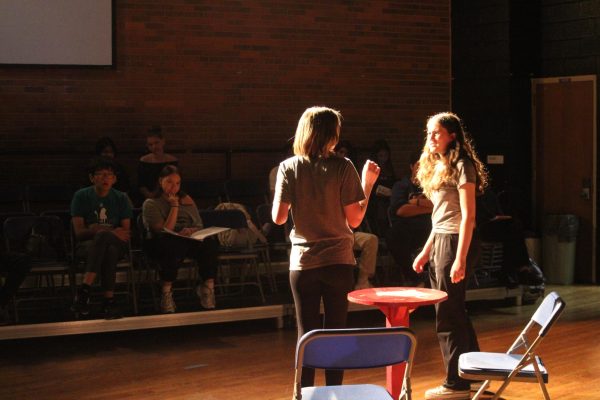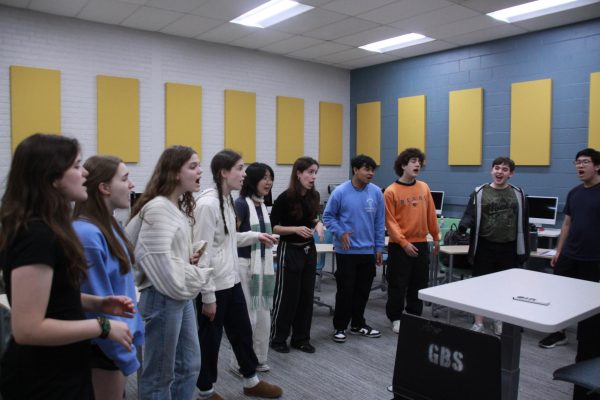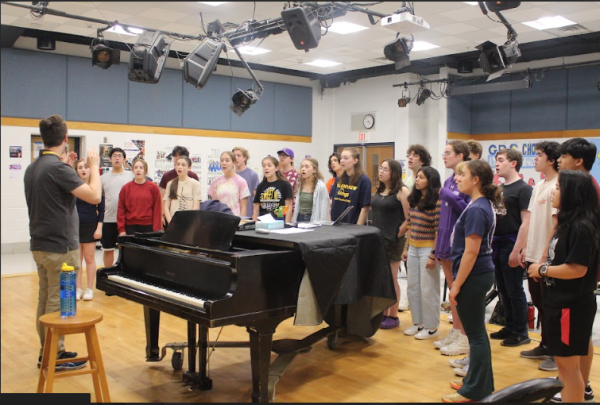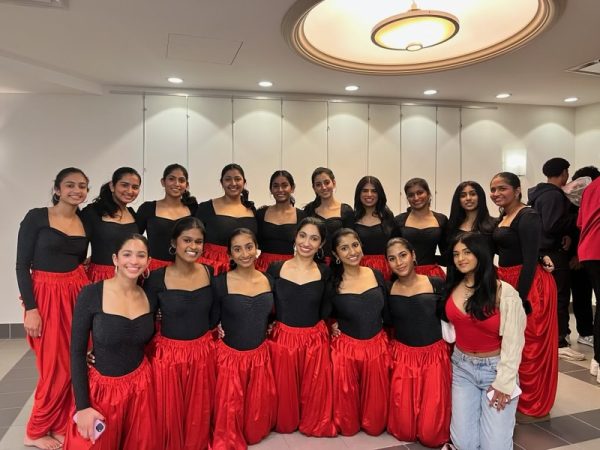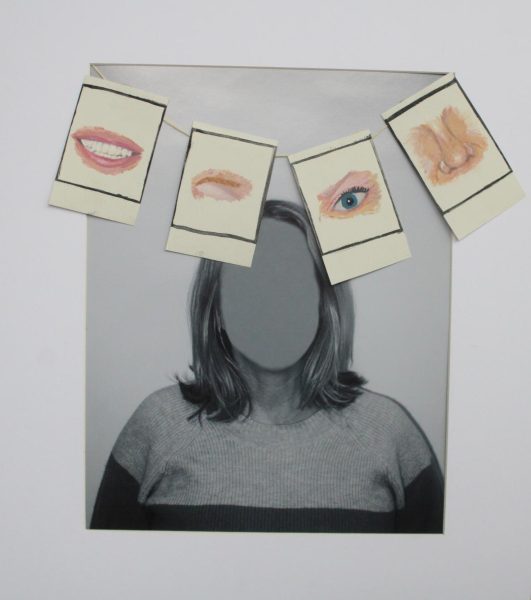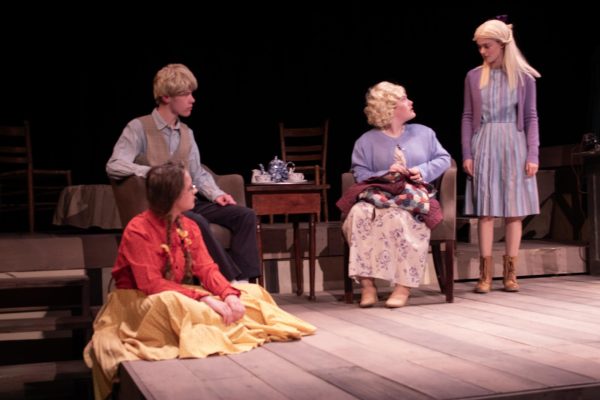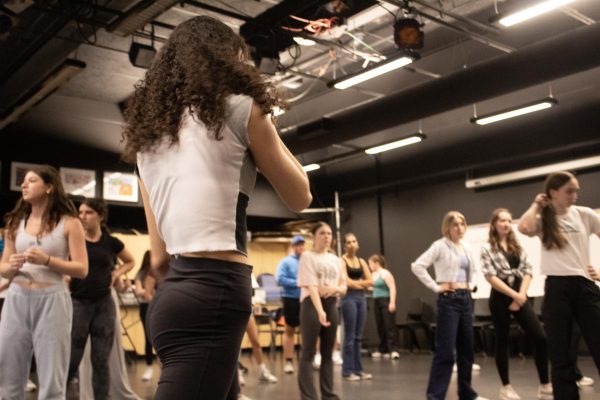Anatomy of Gray strays from traditional tactics
September 28, 2018
The lights begin to flicker and people file back into the auditorium. Muffled conversations die down as people find their seats. The lights slowly dim all the way and the stage suddenly becomes illuminated. However, upon the stage, alongside the set and performers, sits the audience.
John Knight, the director of this year’s fall play, Anatomy of Gray says a unique aspect of the play is the onstage seating. In the past, audience members have sat in the auditorium seats, set slightly apart from the actors. Knight believes bringing the audience onto the stage this year will create a sense of intimacy, however he also believes it will be a challenge for the performers.
“[With this new seating the performers] will see [the audience] and they will be right there,” Knight said. “You can see their eyes and it will very much be a part of the show. I think that one of the fun challenges will be getting that sense of you have to be real, no hiding and no room for falseness.”
Despite the challenge the seating presents, junior Nathan Goldberg says he is excited for the change. While he believes it will be an adjustment, he thinks it will create a more intimate setting overall.
“[With the new seating] you create connections with the audience members and you bring them into the world that you’ve been working on for so long,” Goldberg said. “It’s almost like they’re a part of the world you’re in now and they feel that way too because they’re that close. [The play has] a lot of talking to the audience as if they’re townspeople as well and [the seating is] just bringing everything into one cohesive environment.”
This untraditional idea of bringing the audience onstage is becoming more and more popular, according to Knight. This is done to avoid losing the audience’s interest, Knight says, as they can begin to feel disconnected.
“I have seen a lot of plays on broadway where they put the audience on the stage,” Knight said. “They have seats up there and it is a way of reducing those big stages and creating that intimacy. That is what you always want to do in theatre even if you have a huge space you somehow want to make it intimate. You don’t want to feel as an audience member that you are so far away and everybody looks like an ant.”
Another interesting aspect of this year’s play, according to Neptun, is the process of double casting. This process is when two actors or actresses are assigned to the same role and they switch off between one person playing the main role while another is in the ensemble. Neptun says double casting prevents the same people from being cast as leads while others are cast as ensemble members.
“[Double casting is] just kind of a cool opportunity because it gets more people involved,” Neptun said. “It allows people to get really good at the part their playing but also see a different aspect of the play.”
Knight says this year’s play was chosen in an attempt to challenge the actors and actresses in a new way. While last year’s play, The Inspector General, was more of a farcical comedy, Jim Leonard Jr.’s Anatomy of Gray is a realistic drama centering around a small town. Furthermore, Knight said he found the sense of community in the small town to be a nice parallel to the play cast themselves.
“[“Anatomy of Gray”] is really a moving story that deals with an outsider who comes to a small town,” Knight said. “[It is about] how he is treated and how some people are fearful of outsiders, how some are distrustful and overcome that, and how some are really welcoming and ready to embrace strangers and make them feel at home.”
Agreeing with Knight, Goldberg believes the play delivers several major and overarching themes, which are particularly applicable today. “Just love one another for who they are [and be accepting],” Goldberg said. “Something we could use a little bit more of today is accepting people for who they are and not trying to tar and feather people just because they are trying to help.” Neptun plays the role of June, a persistent young girl from the town of Gray. While many of the townspeople are wary of the newcomer, June is unafraid. Neptun says she finds herself able to relate to June, making her an easier character for her to play.
“While I do think it is good to stick to your roots and get to know everyone in your town really well there is something to be said about branching out and meeting new people,” Neptun said. “Going on your own and experiencing life the way that you want to experience it [is important] because you only get one life so you have to live up to it.”
Similarly, Goldberg finds himself able to connect with his character, the quick-witted Galen P. Gray. According to Goldberg, one of the strongest similarities between the two of them is their religion.
“Being Jewish myself there is a little bit where [Galen P. Gray] speaks in Hebrew and it’s cool because it’s something I can relate to and it’s something of which I already know,” Goldberg said. “I don’t speak fluently but I know enough to kind of understand [what he is saying].”
Neptun says she has been participating in the fall play since freshman year. She says she continues to return because of the feeling she gets through sharing a story with the audience, she says.
“I am definitely someone who does extracurriculars for myself and acting is something that I do not because of the people that I am with but because of the way it makes me feel in the end,” Neptun said. “There is just something about making an audience happy and telling them a story that you know really well, that you’ve practiced. It’s just such a rewarding feeling in the end.”





